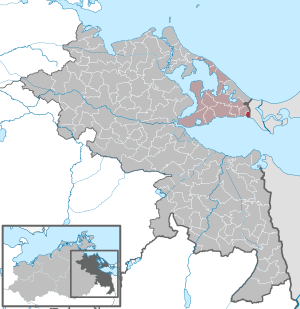Kamminke
| coat of arms | Germany map | |
|---|---|---|

|
Coordinates: 53 ° 52 ' N , 14 ° 12' E |
|
| Basic data | ||
| State : | Mecklenburg-Western Pomerania | |
| County : | Vorpommern-Greifswald | |
| Office : | Usedom-South | |
| Height : | 2 m above sea level NHN | |
| Area : | 2.96 km 2 | |
| Residents: | 247 (Dec. 31, 2019) | |
| Population density : | 83 inhabitants per km 2 | |
| Postal code : | 17419 | |
| Area code : | 038376 | |
| License plate : | VG, ANK, GW, PW, SBG, UEM, WLG | |
| Community key : | 13 0 75 056 | |
| Office administration address: | Markt 1 17406 Usedom |
|
| Website : | ||
| Mayor : | Uwe Hartmann | |
| Location of the municipality of Kamminke in the Vorpommern-Greifswald district | ||
Kamminke is a municipality in the district of Vorpommern-Greifswald in Mecklenburg-Western Pomerania and belongs to the Usedom-Süd office with its seat in the city of Usedom . Until 2005 the community belonged to the Ahlbeck to Stettiner Haff district .
Kamminke is one of the oldest fishing villages on the island of Usedom. Thatched houses and the steep coast determine the flair of the place.
geography
The municipality of Kamminke in the eastern part of the island of Usedom is located in the Achterland , directly on the north bank of the Stettiner Haff . The Golm , which is 69 m above sea level. NN highest point of the island, offers a wide view to Swinoujscie. The border with Poland runs directly on the eastern edge of the municipality ; the seaside resort of Heringsdorf is six kilometers to the north .
Kamminke is an elongated street village at the foot of the Golm - Kamminke cliff. This is up to 28.8 m high in the local area. A lookout point can be reached from the site via a staircase. Part of the place is also above the cliff.
Districts
Desolations and living spaces
- Friedrichsthal (living space)
- Golm (desert)
history
Kamminke
The area around Kamminke shows signs of early settlement. In addition to the Bronze Age barrows (1800 to 600 BCE) west of Kamminke, which belong to the place, there are other barrows on the Golm, as well as a castle wall and a section wall in front of it. But these belong to the Garz district. There is an early German tower hill (from 1230) at the village's cemetery. All of this proves an early and continuous settlement.
The equation of Kamminkes with Camik , mentioned in a document in 1263, is now considered outdated. Based on the sources, Zietlow was able to locate this place, and thus the ancestral seat of the von Kameke family , west of Pudagla on the Achterwasser . As early as 1242, the Dargun monastery had acquired ownership of the neighboring Garz and the Kaseburg, a few kilometers to the east, and thus probably also to the area of today's Kamminke.
Niemeyer only mentions the first mention in 1618 in the Lubin map as "Camincke". But then a continuous mention follows, with a spelling with "C" until 1911, only then changed to "K". The name is interpreted as "stone" or "stone mountain".
After the Peace of Westphalia in 1648, Kamminke became Swedish, like all of Pomerania, and Prussian after the Peace of Stockholm in 1720. After the administrative reform in 1815, Kamminke came to the Prussian province of Pomerania and belonged to the district of Usedom-Wollin from 1818 to 1945 . From 1945 to 1952, the municipality, with the part of the district of Usedom-Wollin that remained in Germany after the Second World War , formed the district of Usedom in the state of Mecklenburg , which was added to the Wolgast district in the Rostock district in 1952 .
The community has belonged to the state of Mecklenburg-Western Pomerania since 1990. From 1994 to 2011 it belonged to the district of Ostvorpommern , which was added to the district of Vorpommern-Greifswald on September 4, 2011 .
On March 12, 1945, American bombers bombed the nearby city of Swinoujscie . The 23,000 people killed in the process were buried on and near Golm. In 1975 a memorial was built on the Golm. On March 13, 2005, the newly built youth meeting place of the Volksbund der War Gravesfürsorge was inaugurated by the Federal President Horst Köhler .
Since 1992, the town center has been extensively renovated with the help of urban development funding. The port for passenger ships and leisure boats was also significantly expanded and modernized.
- Friedrichsthal (living space)
Friedrichsthal was already there before 1880 according to MTB. The place consisted of two parts, the head forester's office on the other side of the peat trench (now the border trench to Poland) and the associated living space on the Kamminker Kliff opposite the forestry yard. Before 1835 there was a forester's house in what is now Forst, which was given up when the forest ranger was established and converted into a normal house. When the village was separated in 1945, the Friedrichsthal forestry department was called “Wydrzany” and the part that remained with Germany was called “Forst”. The latter is now fully integrated into Kamminke and has no district authorization. The ravine driveway to the cliff and the plateau is located at this residential area.
- Golm (desert)
Golm was first called "Golim" in 1690. In 1906 the residential area was listed in the local directory as "Golm". Golm is interpreted from the name as "mountain".
The settlement of the restaurant on the Golm mountain is meant by the village or the residential area . In 1943 it was demolished in order to build a compact flak position to protect the city of Swinoujscie. The place became a desert. Today the place is in the municipality of Garz (Usedom) , as is the entire mountain.
politics
Coat of arms, flag, official seal
The municipality has no officially approved national emblem, neither a coat of arms nor a flag . The official seal is the small state seal with the coat of arms of the region of Western Pomerania . It shows an upright griffin with a raised tail and the inscription "GEMEINDE KAMMINKE * LANDKREIS VORPOMMERN-GREIFSWALD".
Attractions

- Golm Memorial (one of the largest war victims cemeteries in Germany)
- Castle ramparts, barrows and viewpoint to Swinoujscie on the Golm
- Mill on the Kleiner Haff
- Houses with thatched roofs
- Harbor - excursion boats and marina
- Tower hill "Kellerberg" at the cemetery
- Kliff Kamminke with the viewpoint over the place to the border valley - Torfgraben
- Beach
traffic
The federal road 110 north of the municipality is provided with a bridge over the peat canal, which forms the border with Poland. There is a transition here for cars, pedestrians and cyclists. Kamminke is connected to the route network of the Usedomer Bäderbahn .
A shipping company drives two to three times a day from Ueckermünde to Kamminke, bicycles are taken on board.
See also
Web links
- Municipality of Kamminke on the website of the Usedom Süd office
Individual evidence
- ↑ Statistisches Amt MV - population status of the districts, offices and municipalities 2019 (XLS file) (official population figures in the update of the 2011 census) ( help ).
- ^ Pomeranian document book . Vol. 2, 1st department, PUB No. 742.
- ↑ Eduard Georg Heinrich Zietlow: The Premonstratensian monastery on the island of Usedom from its foundation around d. Year 1150 until its abolition i. J. 1535. W. Dietze, Anklam 1858, p. 105 ( Google Books ).
- ^ Pomeranian document book . Vol. 1, 1st department, PUB No. 402. Mecklenburgisches Urkundenbuch . Volume 1: Documents from Dargun Monastery. MUB No. 31. (It remains uncertain whether Kamminke is to be equated with one of the two villages named Gardis - "duas villas sub uno nomine Gardis dictas" - mentioned in the document .)
- ↑ a b Manfred Niemeyer: Ostvorpommern I . Collection of sources and literature on place names. Vol. 1: Usedom. (= Greifswald contributions to toponymy. Vol. 1), Ernst-Moritz-Arndt University of Greifswald, Institute for Slavic Studies, Greifswald 2001, ISBN 3-86006-149-6 . P. 16 ff
- ↑ Main Statute, Section 1, Paragraph 3 (PDF).
- ↑ Line network regional bus UBB. Usedomer Bäderbahn, accessed on May 5, 2019 .



